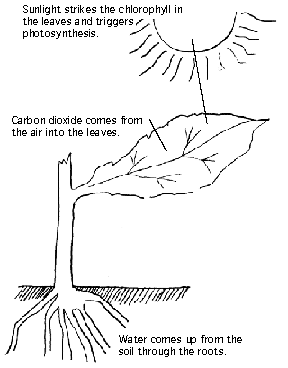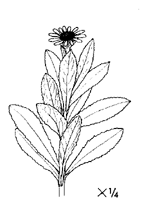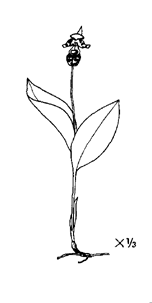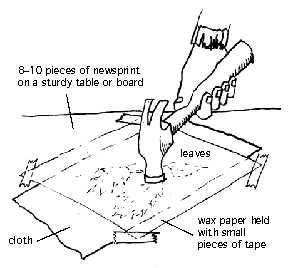|
Txin
achigalix an}a}igumin anuxtanatxin a{saasaduuku{txin.
(E)
|
How Do Plants Make Food?
|
Animals (humans included) cannot make their own food. They get their food by eating plants or by eating animals that have eaten plants. All plants can make their own food with help from the sun. This is the most fundamental difference between plants and animals. Almost all of the differences between plants and animals come from the ability of plants to make food from the sun.
To make food, plants need sunlight, carbon dioxide and water. If you were a plant, you could stand in sunlight and with help from carbon dioxide (that you gather from the air through your leaves) and water (that you gather from the soil through your roots) you would satisfy your hunger. |
|
|
How do light, water and carbon dioxide get into a plant?
In most plants, the leaves are the main food factories. They capture the sun’s energy with the help of chlorophyll in the leaf cells. The chlorophyll traps and packages the energy from the light of the sun in a process called photosynthesis. Leaves usually have a large surface so they can collect the most sunlight. Many plants also have ways to change the leaf’s position to capture the light.
Leaves contain veins—an important part of the plant’s plumbing. If you hold a leaf up to a light, you can see the pattern of its veins. Veins help make the leaf a strong structure. They are also the pipelines that carry food and water in the leaf. The veins in the leaf are part of plant’s main plumbing system, connecting with the stem and the roots. The main plumbing system has two sets of tiny tubes, the xylem and the phloem.
Xylem is the plant’s water supply plumbing system.
Water travels from the soil through the roots, stem, and leaf veins in the tubes called xylem. The veins supply the water to the chlorophyll in the cells. When light strikes the chlorophyll, photosynthesis begins. The chlorophyll absorbs energy from the light. This energy splits the water molecules into atoms of hydrogen and oxygen. The hydrogen atom then combines with atoms of carbon and oxygen to produce a simple sugar. The process is actually many chemical changes with more steps than are described here.
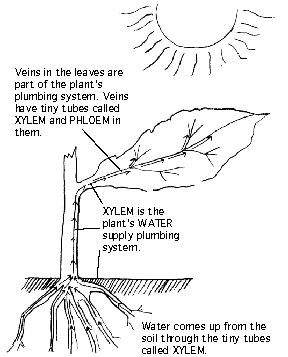 |
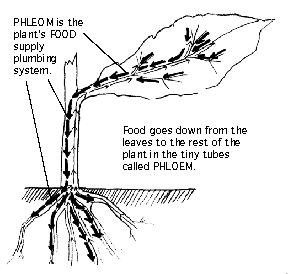 |
Phloem is the plant’s food supply plumbing system.
After the sun’s energy is converted through photosynthesis into simple sugars, this food is carried in the veins through the phloem to the other parts of the plant where it can be used immediately or stored.
Stomata are the places where carbon dioxide enters the leaf and where left-over oxygen and water leave the plant.
|
|
Carbon dioxide from the air enters the plant leaves through tiny pores —mouth-like spaces that can open and close—called stomata. The oxygen left over from photosynthesis passes out of the leaves through the stomata and then into the air. Water also moves from the leaves into the air through the stomata. In the dark, the plant relies on its supplies of sugars and starches and reverses the process of photosynthesis to produce carbon dioxide that passes out of the leaf through the stomata. The opposite of photosynthesis in a plant is called respiration. |
A leaf has many stomata. For example, a cottonwood leaf may have 1 million stomata, and a sunflower leaf nearly 2 million. In most plants that grow in full sun, the majority of the stomata are in the shaded lower side of the leaves. Being on the lower side also protects the stomata form dust and insects. In some plants, especially plants that grow in water, the stomata are on the upper side of the leaf. In other plants, the stomata are about equally divided between the upper and lower side.
Some leaves will show their stomata. Coat the underside of a large leaf
such as a geranium with clear nail polish. Carefully peel the polish off
when it is dry. Look at the print of the leaf with a hand lens or under
a microscope. You should be able to see the shape of the stomata.
![]()
ACTIVITY ONE. You can do an experiment about plants and light using the World Wide Web and other resources.
1. Photosynthesis with Newton’s Apple
2. “Do plants Need Sunlight?” from the University of Michigan’s K-12 Math-Science Outreach Program
http://www.eecs.umich.edu/~coalitn/sciedoutreach/funexperiments/agesubject/lessons/sunlight.html
3. What happens to a leaf if you interfere with its stomata?
“What’s Stomata,” pages 30-31
Janice Van Cleave.
Biology for Every Kid.
4. OR the web site:
http://www.eecs.umich.edu/mathscience/funexperiments/quickndirty/plantstomates.html
![]()
They are seen growing by the beach on banks. They are large plants that grow in bunches. The stem is thick and soft and when pulled they break easily. From the bottom there are leaves that grow up and around the stem to the top. It has lots of leaves. The leaves are large and the surface is shiny. The bottom side is light, worn out, hairy and soft. On the very top grows a yellow flower. The flower is large in size. The middle looks straight. The flower’s leaves look like they are torn. They are yellow and grow around the stem. Translation by Moses L. Dirks When asked about the plant above, Unangan Elder, Sophie Sherebernikoff of Unalaska said, “You don’t see many of those plants around here anymore. They have extended the gravel for the road over the bank where they used to grow.” She does not remember ever hearing a name in Unangam tunuu for her favorite flower, the lady’s slipper (Cypripedium guttatum). She would appreciate it if anyone knows it and would share it with us. Sophie and an aacha{, or special friend, lament the fact that the squirrels, brought in to provide food for the fox farms in the 1800s, love to eat lady’s slippers. Sophie Sherebernikoff, Unangan Elder, from Unalaska |
![]()
|
|
|
ACTIVITY TWO. You can be a chemical messenger in the Leaf Food Factory, a game about photosynthesis (See game pages and directions in the Appendix) ACTIVITY THREE. You can show a leaf’s chlorophyll on a fabric! Make a hammered leaf print. Sometimes attributed to the Cherokees, this is an age-old way to create a leaf print on fabric. You will transfer the natural color from the leaves to a fabric by beating the chlorophyll directly into the cloth fibers. 1. Wash your cotton fabric in water and a natural soap such as ivory. This wash removes a chemical that textile manufacturers put in the cloth to keep it looking fresh until it is sold. Do not use fabric softeners. Rinse thoroughly and dry. 2. Prepare the work surface: Lay 8-10 pieces of newsprint in a pile on a sturdy table or board. (Trying a small sample at this step with the following directions will help you get the feel of hammering the leaf so that you keep the pattern and shape of the leaf while transferring the color to the fabric) |
3. Lay your cloth, right side up on the newsprint.
4. Lay your leaves on the cloth, top-side down, in a pattern of your choice.
5. Cover the leaves with a sheet of wax paper. Using small pieces of tape, fasten the wax paper around its edges.
|
6. Pound evenly with a hammer until the color transfers to the cloth. 7. “Fix” the color in the cloth using one of these chemicals: ferrous sulfate, alum, or wood ashes. These are called mordants in the natural dye process.
For reddish hues, soak the cloth for 5 minutes in a solution of one gallon (3.75 liters) of cold water in which 1/3 cup (80 ml) of wood ashes is dissolved. (Note: different kinds of wood burned to make the ashes will affect the color differently.) 8. Rinse the fabric in cold water and air-dry away from direct sunlight. |
|
|
9. You can soak the fabric for 10 minutes in one more fixing bath of:
1/4 cup salt (60 ml) per one gallon of water.
OR 3 tablespoons (44 ml) of baking soda to one gallon (3.8 l) of water.
OR 2 cups (1/2 l) washing soda to one gallon (3.8 l) of water.
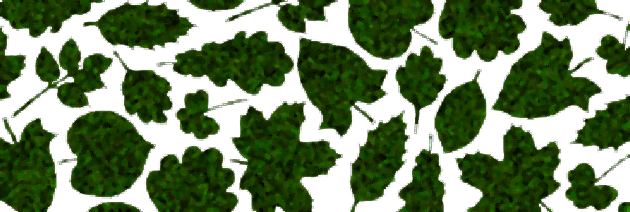
|
VOCABULARY |
||
| atoms bonds carbon carbon dioxide cell wall chemical formula chlorophyll chloroplast chromosomes |
cytoplasm hydrogen mitochondria molecules mordants nucleus oxygen oxygen phloem |
photosynthesis respiration stationary stomata stoma transpiration vacuole xylem |
ACTIVITY FOUR. You can visit your personal place.
It’s time to return to the place you picked a few weeks ago when you started the plant studies. For homework tonight, visit your personal place again. What has changed in your personal place? Write one paragraph in your log book describing the changes. If there have been no changes, describe the reasons why.
INSIDE THE PLANT CELL
|
What is in a plant cell in addition to the chlorophyll? Chlorophyll is an important part of plant’s cell. Some of the other important parts of the plant cell are the cell wall, the nucleus, the cytoplasm, the vacuole and the mitochondria.
As you read this description and look at the illustration, think about objects you might find or make to represent each cell part. After you read the description, look at the virtual cell and its parts on the Web: http://www.life.uiuc.edu/plantbio/cell The plant’s chlorophyll is in a small part of the plant cell called the chloroplast. There are many of these in each plant cell. The chloroplasts are in a liquid-like part of the cell called the cytoplasm. |
|
|
Mitochondria are also found in the chloroplast. They are the power factories for the cell, changing the food in the cell into energy so that the cell can grow, divide and do its work.
The nucleus is the control center for the cell. This is where the chromosomes are that determine the next generation of this plant’s reproduction.
The cytoplasm is all the material enclosed by the cell wall, except for the nucleus. Some of the space inside the cell is taken up with a fluid-filled vacuole that presses out and helps keep the cell rigid.
The outer cell wall of the plant cell is rigid, unlike animal cells which are flexible.
ACTIVITY FIVE. You can make a cell model.
Make a plant cell model, remembering that plant cells are different than animal cells. You can find some construction suggestions at:
Jello cell:
http://ericir.syr.edu/Virtual/Lessons/Science/Biological/BIO0035.html
3-D cell:
http://ericir.syr.edu/Virtual/Lessons/Science/Biological/BIO0039.html
Include all these parts in your cell model:
cell wall, nucleus, cytoplasm, vacuole, mitochondria, and chloroplasts.
EXTENSIONS:
ACTIVITY A.
Use flower petals in addition to leaves to make a hammered plant print.
ACTIVITY B.
Collect plant materials and use them to dye fabrics or yarn or grasses.
ACTIVITY C.
Make an edible leaf and learn more about leaf structures in “Build a Tree, Make A Leaf,” Alaska’s Forests & Wildlife, Alaska Wildlife Curriculum Teachers’ Guide, Alaska Department of Fish and Game. 1995
ACTIVITY D.
You have looked at the photosynthesis process of plants. There are other important steps in the food-producing work of plants. In your library or on the Web, research the respiration cycle of plants or the transpiration cycle of plants. Make an illustrated poster showing how photosynthesis, respiration and transpiration work.
ACTIVITY E.
Have you ever asked yourself why a leaf is green? The answer might surprise you. Research the light and colors in leaves. Explain how leaves use the blue and red parts of light to make their food. They reflect (do not use) the green light. Do a color experiment for the pigments in leaves such as “Leaf Colors” pages 38-39 in Janice Van Cleave’s Biology for Every Kid. Make a display of your work and include a description of the differences between color in light and color in pigment.
http://photoscience.la.asu.edu/photosyn/education/colorchange.html
| Student
Assessment, Section Four |
Name: ____________________________ | ||
| Date: __________________ | 1. Always | 2. Sometimes | 3. Never |
| I stayed on task. | |||
| I completed my work. | |||
| I asked questions. | |||
| I contributed to my group's work. | |||
| I was respectful of Elders and values. | |||
| I understand the information. | |||
|
I still have questions about:
|
|||

